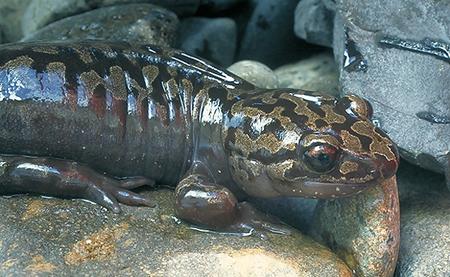Salamander - Pacific Giant
California Giant Salamander Scientific Name: Dicamptodon ensatus
Thu, 25th April, 2024 - 7:48 am GMT
Sponsor Ads:

Alternative Name
California Giant Salamander Scientific Name: Dicamptodon ensatusBasic Info
The Pacific Giant Salamander can reach lengths of up to 14 inches at maturity. Their teeth grow in a broken or continuous line out of the roofs of their mouths. Generally, the bodies of Pacific Giant Salamanders have a thick appearance. The characteristic background color of the Pacific Giant Salamander tends to be brassy brown, gray brown, or gray, with a marbled pattern in black overlaid. Generally, their undersides are paler and lack a marbled pattern. Pacific Giant Salamanders usually lighten in color as they age. There are four toes on the front feet and five on the hind feet, and small gills are also present at maturity. Neoteny may be evident in this species. This means that rather than developing into a terrestrial adult, some Pacific Giant Salamanders may remain in an aquatic state for their entire life cycles. Males generally have more swollen cloacas than females and often have longer tails.
Health
Pacific Giant Salamanders should have plenty of hiding places. They prefer cool temperatures, although they may be tolerant of temperatures over 85 degrees Fahrenheit for short periods. It may be preferable to have a filter in the tank of a Pacific Giant Salamander that creates a sort of current and keeps the water well aerated. Breeding Generally, Pacific Giant Salamanders do not breed until they are about six years old. The breeding season probably lasts from spring through fall, and during this time the male will produce spermatophores. It is not understood how the female Pacific Giant Salamander picks these up. She will eventually lay between 85 and 200 eggs in a hidden underwater area. They may be laid in a clump, or singly, and she will fiercely defend her eggs for up to seven months. The eggs are usually attached to some surface. The larvae that hatch live off of the yolk from their eggs for another three months before leaving the nest, and because of the time consuming nature of guarding them, female Pacific Giant mothers get little to eat. Due to the stress of reproduction, these salamanders are only reproduce once every two to three years.Habitat
Generally quite secretive and nocturnal, Pacific Giant Salamanders spend the majority of their days hidden under leaf litter, damp moss, or rotten logs. They are most often found on forested slopes and may only come out in daytime, during periods of heavyBehavior
The Pacific Giant Salamander is a strikingly large salamander. Although generally secretive, these animals can be quite fascinating to observe in the wild. In fact, the Pacific Giant is one of the only species of salamander that can bark. Although they generally remain on the ground, Pacific Giant Salamanders have been known to climb trees and also seem to be good at digging. They generally eat insects like slugs or worms, but may also eat small snakes, other salamanders, frogs, and even small mammals. When they are alarmed, Pacific Giant Salamanders can make a noise that is similar to the low yelp of a dog. In addition, this salamander can secrete a foul-tasting milky substance from glands located on the top of its tail in order to defend itself from other animals. In their home regions, Pacific Giant Salamanders tend to be territorially aggressive toward other adults in their area. They may be preyed upon by animals like otters, weasels, minks, birds, and even fish like trout. It reproduces rather slowly, and is also sold in the pet trade. It is sometimes confused with the Coastal Giant Salamander.Origin
Pacific NorthwestHistory
Generally found in quiet areas that have not been exploited for timber, Pacific Giant Salamanders are located throughout the Pacific Northwest of North America, in coastal areas from Canada's British Columbia south to northern California in the United States. Because their habitat is being destroyed, the Pacific Giant Salamander has become endangered in many areas of its range.Common Foods
feeds primarily on insects, earthworms, small rodents, small animals.Sponsor Ads:
"Now that principle of an act, whether good or bad, is choice and wish, and all that accords with reason. It is evident, then, that these also change. But we chage in our actions volulntarily. So that the principle also, choice, changes voluntarily. So that it is plain that it will be in our power to be either good or bad." -- Aristotle. Magna Moralia.
Salamander - Pacific Giant
Coded by: BGID® | ALL RIGHTS RESERVED Copyright © 2000-2024
Disclaimer | Privacy | Report Errors / Contact | Credits













